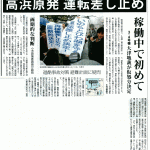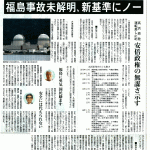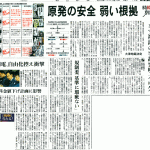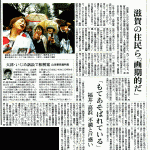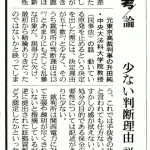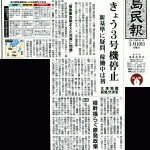Original Japanese written by staffer
The English below written and arranged by Heeday, based on the original Japanese
The English edited by Rev. Dr. Henry French, ELCA
Articles from the March 10th, 2016 editions of the Asahi Shimbun, Fukushima Minpo, and Akahata newspapers
Sorry, no English summary of the Japanese articles is available.
The court’s ruling
29 residents of Shiga Prefecture, right next to Fukui Prefecture where Kansai Electric Power’s Takahama Nuclear Power Plant (NPP) is located, filed an appeal at the Ohtsu District Court to suspend the operation of Units 3 and 4 of the NPP which were restarted in January and February of this year. The chief judge, Yoshihiko Yamamoto, gave a provisional ruling, suspending the two units’ operations. The judge brought up questions concerning the NPP’s countermeasures to protect against earthquakes and tsunami. He also questioned the escape plans for residents in the NPP’s vicinity, pointing out that the causes of the Fukushima Daiichi meltdown have yet to be identified. He judged that Kansai Electric’s proof of the NPP’s safety is insufficient.
The result
The ruling took effect immediately. Of the two units in question, Unit 4 was already out of operation due to a technical problem. Thus, Kansai Electric has to stop the operation of Unit 3 on March 10th. At the same time, the power company plans to file an objection to the ruling and request a stay of execution at the same court. Unless this objection and/or the request are admitted, the court’s ruling to suspend the two units’ operations will remain legally valid.
Responsibility of the operator
The court’s ruling holds that the operator of a NPP has the responsibility to prove its safety, since the operator possesses the relevant data. If the operator is unable to give sufficient proof of safety, one can justly suppose that the operator’s judgments may be faulty.
The judge said —
The judge also pointed out that, considering how serious the meltdown of TEPCO’s Fukushima Daiichi has been, a major NPP accident can cause environmental disasters whose affects go beyond national borders. This can more than offset any energy efficiency a NPP might produce. Thus, according to the judge, NPP safety standards should be strict enough to prevent an accident, even if some safety measures are considered extreme. The judge went on to say that the starting point of future safety standards, i.e., the causes of Fukushima Daiichi’s meltdown, “have yet to be identified.” In spite of this, the Nuclear Regulation Authority (NRA) has set up new safety standards for NPPs. The judge said that he was “seriously worried” about the NRA’s attitude and “reluctant to believe that the NRA’s new safety standards and examinations are good enough to secure the peace and safety of society.”
Safety measures declared insufficient
Then, the judge described the court’s decision with respect to the severe accident prevention measures at the Takahama NPP. As a power company designs earthquake-proof buildings, it assumes standard earthquake motions. With respect to such motions, the judge decided that the active fault lengths that Kansai Electric Power assumed were inaccurate. This inaccuracy led to insufficient earthquake-proof designs, according to the judge. He also brought up, as a piece of evidence throwing doubt on the sufficiency of Kansai Electric’s countermeasures, literature reporting on the Tensho Earthquake of 1586, which caused devastation from a tsunami to the Wakasa Region, which includes Takahama, The judge went on to say that, even under the new safety standards, the cooling systems of water pools storing used nuclear fuel are more vulnerable to earthquakes than reactors are. Thus, the judge claimed, Kansai Electric did not have good countermeasures to protect against damage to such a pool which could lead to the leakage of cooling water.
A brave judge
The judge also brought up the escape plans prepared by the municipalities around the Takahama NPP and said that, “We have an urgent need to prepare specific escape plans under the initiative of the national government.” He also said, “We need a more comprehensive regulatory standard that covers such new escape plans as well. Japan’s national government today has the obligation, under the principle of faith and trust, to define such a new standard.” Thus he criticized the national government, which has been promoting NPP restarts under the existing safety regulations – something unusual for a court judge to do.
Right to live in peace
The plaintiffs in this court case, who live within 30 to 70 km (19 to 44 miles) of the Takahama NPP, claimed that a serious accident at the NPP would violate their personal right to live in peace and with good health. The court ruling agreed that such a violation would be highly probable in the case of a serious accident.
Takahama’s own weakness
As you know, at Fukushima Daiichi, they cooled down the reactor cores with a gigantic volume of water, and stored the contaminated water in tanks within the NPP’s premises. In contrast, Takahama has very limited premises, which cannot accommodate many huge water tanks. In the case of a meltdown or another serious accident, how can they take countermeasures given the limited premises? To aggravate the matter, there are not many escape routes available to the residents around Takahama. If a major earthquake hits, rescue vehicles would experience difficulties reaching their destinations.
The Japanese author’s wish
Now, five years after the meltdown began at Fukushima Daiichi, the Ohtsu District Court’s ruling precisely pointed out deficiencies in existing safety measures of NPPs. We must not let another Fukushima tragedy happen. I am convinced, therefore, that the NRA and the power companies have to face the problems pointed out by the court and respond with integrity.

